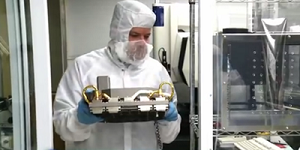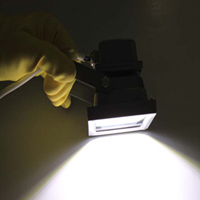Oxygen Cleaning: A Validated Process is Critical for Safety
From time to time, we re-publish well-received or particularly valuable articles that have previously run on 名媛直播Magazine.com so that those who might have missed them will be able to catch up on the best of the best.
Oxygen is the most common oxidizing gas and is, of course, highly reactive. When dealing with an oxygen-enriched environment, it is important to control the sources of ignition. Ignition can be caused by many things, among them:
- Electrical arcs, which can come from electrical equipment or even static discharge
- Friction, which can be generated by the sliding contact of materials within the oxygen-enriched environment
- Impact of particles or projectiles internal or external to the enriched environment can generate heat
- Resonance, which is vibration-induced heating
- Heat of compression is the most common cause of explosion due to contamination. Heating is caused by the adiabatic compression of a fluid; this is often called autoignition.
Autoignition is the phenomenon of spontaneous ignition of a fuel source due to the heat generated by the sudden compression of a gas or HoC. When a valve in a high-pressure or high-velocity oxygen flow is opened or closed quickly, the kinetic energy is converted to increased temperature and potential energy in the form of increased pressure. If the temperature generated by the compression exceeds the temperature needed to ignite non-metallic seals or even the pipe itself, the result is a spontaneously explosion or autoignition. When this happens in oxygen systems, the effect can be devastating.
Because the HoC is substantial and can generate thousands of degrees of temperature even at moderate pressure ratios, oxygen systems are designed to limit the pressure drops to control HoC and limit temperature within the autoignition temperatures of the system components.
Thus, it is absolutely essential that contaminants, which can introduce lower auto-ignition temperatures than even the non-metallic seats and seals, be removed from any oxygen system. Any method that achieves the desired cleanliness level is acceptable. CGA 4.4 and the recently issued MSS-SP-138 provide excellent recommendations for cleaning processes.
Contaminants to be Removed
Basically, anything that promotes combustion or impact product purity is considered a contaminant. ASTM G93 categorizes contaminants into three types:
Organics
- VOC compounds
- Hydrocarbon based greases and oils
Inorganics
- Nitrates
- Phosphates
- Water-based detergents and cutting oils
- Acids/solvents
Particulate
- Particles, lint and fibers
- Dust - Weld slag, etc.
Cleaning Methods
Mechanical cleaning is used to remove scale, coatings, paint, weld slag and other solid contaminants and can include grit or ice blasting, wire brushing and grinding.
Aqueous cleaning can be with hot water and steam cleaning or alkaline cleaning. Hot water and steam cleaning is effective against water-soluble contaminants, and is normally used with detergent. Alkaline cleaning uses caustic salt in water to create a highly alkaline solution. It is effective against hydrocarbon oils, grease and waxes, and generally is enhanced by agitation and/or jet spraying. Typically this is used for industrial parts washers. This process is greatly enhanced by ultrasonic agitation, but the solvent residue must be removed as well.
Semi-aqueous cleaning uses hydrocarbon solvent and water emulsion, which is effective for removing heavy contaminants from parts like heavy grease wax or hard to remove soils. Emulsion may require agitation to maintain the mixture, and parts must be rinsed before the emulsion can dry. Otherwise, contaminants may re-deposit on the part that was cleaned.
Acid cleaning varies substantially based on the acid used.
- Hydrochloric acid is used to remove scale, rust and oxides. and to strip platings (chrome, zinc, cadmium, etc.) and other coatings
- Chromic and nitric acid are used to for passivating, deoxidizing, brightening and removing alkaline residues in addition to cutting oils
- Phosphoric removes oxides, light rust and fluxes
Acids must be removed completely from the part prior to drying and, depending on the acid strength, may need a neutralizing process.
Solvents can be used without water dilution or emulsion. Alcohol is a common solvent often used to revisit areas of concern identified by black (UV) light inspection. Solvents like alcohol evaporate completely, leaving no residue.
Vapor degreasing is a process in which a solvent is heated until it vaporizes, while the part is maintained at a lower temperature. The solvent then condenses and dissolves contaminants. The part must be oriented so that the condensed solvent can drain from the part by gravity. This method is very effective for inaccessible areas on parts but requires a contained environment for the part during the process.
Any combination of cleaning methods that achieve the desired cleanliness level is acceptable.
Inspection Methods
Indirect visual inspection is done in two ways: wipe test and solvent filtering. A wipe test can identify contaminants in locations that have no direct line of sight. Typically, both white light and UV light are used on the wipe cloth, and are effective in detecting contamination down to 30 mg/m^2. Solvent filtering rinses the inaccessible area in solvent, which is then filtered to capture contaminants. The filter is then visually inspected and can detect 100ml/sq/ft of low residue solvent and it also uses white and UV light.
Quantitative inspection is done by evaporating the solvent used for cleaning and obtaining the weight of the remaining effluent. Acceptable levels of residue vary according to user requirements.
Additional Considerations
Clean room: This provides a designated location where the environment limits dust airborne particles, where clean tools and clean assembly and test equipment can be stored. It can also provide controlled lighting for visual inspections.
Clean test equipment: Pressure test equipment contains contaminants in hoses and pumps. If a test machine cannot be dedicated for clean testing, give special consideration to cleaning of test equipment or alternate testing with clean gas.
Packaging: After cleaning, give specific instructions on how to package the product to preserve cleanliness in shipping and subsequent storage. Consider the role of desiccant as a possible contaminant. Use compatible products or control desiccant to prevent contamination. Consider the addition of actuation and accessories to the valve. Can the actuator be installed and set up without violating the protection? If the protection is compromised, are there procedural steps to identify and remediate any contamination?
Summary
Oxygen cleaning is used to remove contaminants that can significantly reduce the temperature of autoignition. There are many methods for doing the actual cleaning. CGA 4.4 and the recently issued MSS-SP-138 provide excellent recommendations, but any method that achieves the desired cleanliness level is acceptable. It is important to know what level of cleanliness your standard process produces. Process validation using a quantitative measurement allows the supplier to have confidence in process quality when using qualitative inspections for production work.
David Escobar is director of engineering at Metso Automation. Reach him at david.escobar@metso.com.
RELATED CONTENT
-
Effective Check Valve Selection and Placement for Industrial Piping Systems
When planning a check valve installation, the primary goal is to achieve a valve and piping system that offers the longest service life at the lowest cost.
-
Back to Basics: The Nuts and Bolts of Torque and Tension
Torque is a force that causes an object to rotate, while tension is a force that causes an object to stretch or elongate.
-
The Misunderstood Check Valve
Too often this valve is unjustly blamed when problems occur, but the real culprit is its use in the wrong applications.









 Unloading large gate valve.jpg;maxWidth=214)